Understanding Electric Brooder Heaters in Poultry Management
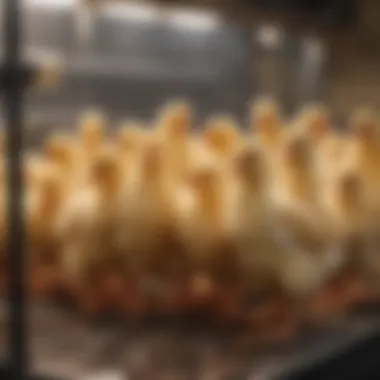
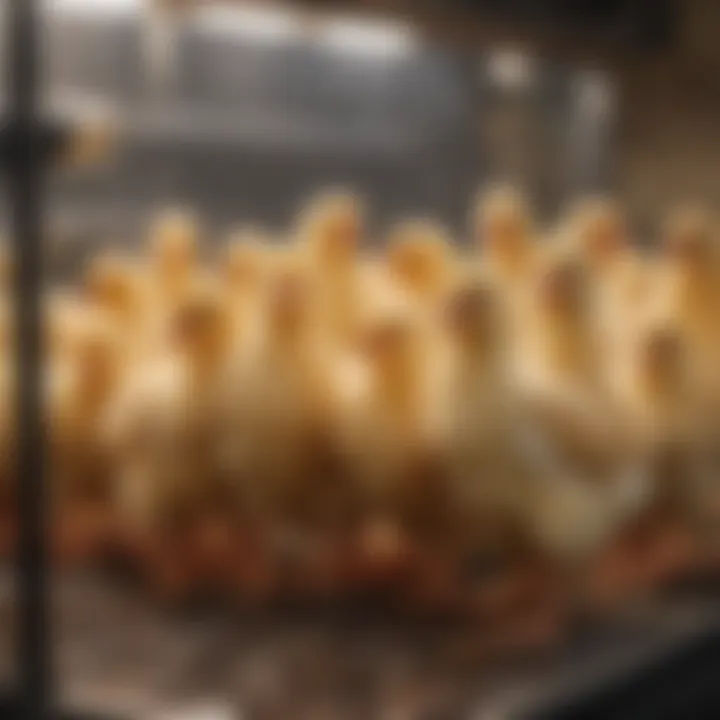
Intro
Electric brooder heaters are essential tools in poultry management. They create a controlled and warm environment, which is crucial for the health and growth of chicks. Without adequate heating, young birds can suffer from stress, poor development, and high mortality rates.
In recent years, the poultry industry has seen significant advancements. The introduction of electric brooder heaters aligns with sustainable practices while enhancing the productivity of poultry farms. This article reviews their importance and practicality in modern farming.
Topic Overview
Definition and Importance
Electric brooder heaters offer consistent warmth to chicks during their early and vulnerable stages of life. These heaters maintain the ideal temperature, usually around 32 to 35 degrees Celsius, which can be adjusted as chicks grow older. This environment supports their metabolism and ensures strong immune systems.
Maintaining an optimal temperature using brooder heaters is vital. It prevents issues such as chill stress, which hinders development. Moreover, a stable temperature helps prevent the spread of diseases through temperature fluctuations.
Brief History and Evolution
Historically, farmers relied on traditional heating methods like coal stoves and incandescent bulbs. These methods, while functional, posed risks such as fire hazards and uneven heating.
With the move towards more energy-efficient systems, electric brooder heaters emerged in the late 20th century. These units utilize modern technology to offer better temperature control and energy efficiency. Over the years, designs have improved, emphasizing safety, portability, and user-friendliness. Today, there is a wide variety, from simple models to advanced systems equipped with thermostatic controls.
Key Techniques and Innovations
Sustainable Farming Practices
Electric brooder heaters often align with sustainable farming principles. Many growers now prefer heaters that use less energy. Several manufacturers design heaters that reduce the carbon footprint, promoting better ecological practices in poultry management.
By using such equipment, poultry farmers can mitigate environmental impact while ensuring the well-being of their flock. This aspect remains crucial as the agricultural community moves toward more responsible farming methods.
Advanced Agronomic Technologies
Recent innovations in brooder technology include automated controls and monitoring systems. These features allow farmers to track temperature and humidity levels in real-time. Such technologies minimize human error and ensure that chicks receive consistent care.
Additional features now available include smart connectivity, allowing farms to use data analysis for better decision-making. With the integration of sensors, some modern heaters even alert the farmer if conditions deviate from the optimal range.
Practical Applications
Step-by-Step Guides
- Choose the Right Heater: Evaluate the size of your poultry house and the number of chicks to select an appropriate model.
- Installation: Position the heater centrally in the brooding area. Ensure no drafts can affect the heater's performance.
- Set Temperature: Adjust the heater to the recommended temperature for the chick's age. Monitor regularly for fluctuations.
- Insulate: Ensure the brooding area is insulated to maintain temperature without wasting energy.
- Regular Monitoring: Continuously check the conditions to ensure chicks are comfortable. Look for signs of distress or cold.
Case Studies or Real-World Examples
Many poultry farms across the world have adopted electric brooder heaters. For instance, Whitestone Poultry Farm in Ontario reported a 20% increase in chick survival rates after switching to modern heating solutions. The farmers noted that the advanced heating systems enabled them to maintain better climate control, which was crucial during cold seasons.
Such real-world examples support the benefits of using electric heaters and highlight the importance of adaptability in poultry management.
"Adopting electric brooder heaters has revolutionized the way we raise chick. Consistent heating leads to healthier birds and better productivity." – John Doe, Poultry Farmer.
In summary, electric brooder heaters play a pivotal role in poultry management today. By understanding their importance, selecting the right technology, and applying effective practices, farmers can ensure healthier chicks and improved efficiency.
Prolusion to Electric Brooder Heaters
Electric brooder heaters play a significant role in poultry management, specifically in providing a controlled environment for young chicks. The first few weeks post-hatching are critical for the survival and growth of these chicks. Therefore, the use of a reliable heating system is vital to ensure their welfare and productivity. In this section, we will explore the definition and functionality of electric brooder heaters, along with their importance in poultry farming.
Definition and Functionality
Electric brooder heaters are devices designed to provide heat to chicks in the brooding stage of their life. They are essential in simulating the warmth that a mother hen would offer. These heaters use electricity to generate heat, often allowing for precise temperature adjustments depending on the needs of the chicks.
The typical functionality involves heating elements that radiate warmth, similar to how the sun warms the earth. Most systems are equipped with a thermostat to maintain a constant temperature, reducing the risk of overheating or inadequate warmth. Different types of brooder heaters, such as conventional models, infrared ones, and radiant heaters, each utilize different mechanisms to deliver heat effectively. Their core purpose remains the same: to ensure chicks have access to the heat they require for optimal growth.
Importance in Poultry Farming
The importance of electric brooder heaters in poultry farming cannot be overstated. Proper heating is fundamental for several reasons:
- Thermal Comfort: Chicks are unable to regulate their body temperature efficiently. Electric brooders provide a warm environment, ensuring that the chicks can thrive.
- Growth Rate: Chicks kept at an optimal temperature grow faster and more uniformly. This translates into better feed conversion rates and ultimately, more profitable outcomes for farmers.
- Health Benefits: A well-regulated temperature prevents stress and susceptibility to diseases in young birds. It reduces the risk of hypothermia during the critical early weeks of growth.
In summary, electric brooder heaters are not just appliances; they are integral to the success of poultry farming. They directly influence the health, growth, and overall productivity of the flock, making them indispensable tools for any serious poultry farmer.
Types of Electric Brooder Heaters
Understanding the types of electric brooder heaters is essential for poultry management. Each type offers unique benefits and considerations that can significantly impact the health and growth of chicks. Choosing the right heater not only affects temperature regulation but also influences overall energy efficiency and cost management. Below, we delve into three primary types: conventional electric brooders, infrared brooder heaters, and radiant heaters. Each has distinct characteristics that cater to different farming needs.
Conventional Electric Brooders
Conventional electric brooders utilize standard heating elements to warm the air in a specified area. They generally come with a metal exterior and a vent for air circulation.
- Efficiency: These heaters provide a consistent and direct heat source that effectively warms the surrounding area. This is crucial for newly hatched chicks, which require a stable environment to thrive.
- Setup: Installation is straightforward, making them accessible to farmers of all experience levels. Many models are portable, which allows for adaptability as the flock grows.
- Cost-Effective: While initial investment costs are relatively low, they may not be as energy-efficient as some alternatives.
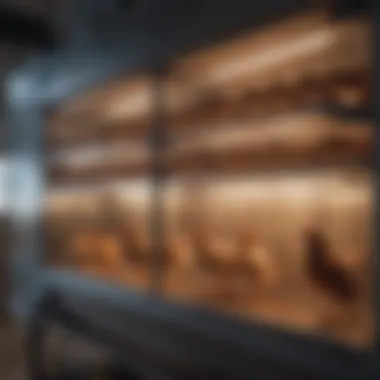

Conventional electric brooders also offer basic temperature control without many automation features. As chicks grow, farmers may need to adjust the settings manually.
Infrared Brooder Heaters
Infrared brooder heaters employ infrared radiation to provide heat, warming objects directly rather than just the air. This heating mechanism can be more efficient in certain scenarios.
- Direct Heat: Infrared heaters can raise the temperature felt by chicks without needing to heat the entire room. Chicks can move closer or farther from the source to regulate their comfort levels.
- Energy Efficiency: These heaters often consume less power compared to conventional models, as they target heat directly rather than dispersing it into the air. This can lead to savings on electricity bills.
- Durability: Infrared heaters are also known for their long lifespan. This durability can offset the initial purchasing expense, making them a suitable investment for long-term poultry operations.
Potential downsides include the need for careful monitoring to ensure chicks do not get too close, as direct infrared heat can lead to overheating.
Radiant Heaters
Radiant heaters function similarly to infrared heaters but use different mechanisms to emit heat. These units often have a larger surface area and can cover more space effectively.
- Widespread Coverage: Radiant heaters offer broad heat distribution, making them suitable for larger brooding areas. They help maintain stable temperatures across larger flocks more uniformly.
- Temperature Control: These heaters frequently come equipped with advanced temperature control systems, allowing for precise adjustments based on real-time measurements.
- Comfort for Chicks: Chicks are more likely to choose their ideal temperature zone, resulting in better thermal comfort and lower stress levels.
However, the complexity of installation and higher upfront costs may deter some small-scale poultry farmers. It is essential to carefully evaluate the specific needs of the flock and the operational budget when considering radiant heaters.
In summary, the selection of the right type of electric brooder heater is crucial for optimizing chick comfort and growth. By understanding the nuances of conventional electric brooders, infrared brooder heaters, and radiant heaters, poultry farmers can make informed decisions that enhance their operations.
How Electric Brooder Heaters Work
Electric brooder heaters are essential in poultry management. Their primary role is to create a stable and comfortable environment for young chicks. When planning to use these heaters, it is vital to understand how they function. This knowledge can determine the health and growth of chicks, making it a critical aspect of poultry farming.
Heat Distribution Mechanisms
Heat distribution is crucial for effective brooding. Electric brooder heaters provide even warmth, which is imperative for the survival and wellness of poultry. There are multiple mechanisms through which heat is disseminated:
- Direct Radiant Heat: Many electric brooders employ radiant heat, which warms the chicks directly. This type of heating mimics natural sunlight, allowing chicks to bask in warmth. The heater's surface heats up and radiates energy.
- Convection: This involves the circulation of warm air around the brooder. Heat rises and creates a warm air layer above. The chicks below benefit from this rising heat. This method ensures all chicks receive adequate warmth.
- Infrared Technology: Some modern heaters utilize infrared technology to warm objects and animals within a designated space. This method minimizes wasted energy and promotes efficient heat usage.
Understanding these mechanisms can help poultry farmers select the right type of heater for their specific needs. Proper heat distribution directly influences the chicks' growth and overall health.
Temperature Regulation and Control
Temperature regulation is another vital function of electric brooder heaters. Keeping the temperature steady prevents stress in chicks, which can lead to health issues. Various features aid in maintaining optimum conditions:
- Thermostats: Most electric brooders are equipped with thermostats that monitor and adjust the temperature automatically. This helps maintain consistency, especially during changing weather conditions.
- Temperature Sensors: Advanced models often include sensors that provide real-time temperature readings. Farmers can easily monitor conditions and make necessary adjustments.
- Programmable Settings: Some heaters allow for programmable temperature settings. This feature is especially useful for managing different brooding stages. As chicks grow, their temperature needs change, and having a system that adjusts accordingly is beneficial.
Managing the temperature properly is essential for chick welfare. Proper heating reduces the risks of both overheating and hypothermia, promoting healthy growth and development.
Selecting an Electric Brooder Heater
Choosing the right electric brooder heater is crucial for effective poultry management. Selecting a proper heating solution can influence not just the immediate comfort of chicks, but also their growth rates and overall health. Farmers need to take several elements into account when making this decision to ensure an optimal environment. Each factor contributes to the broader goal of achieving a productive and efficient poultry operation.
Assessing Poultry Size and Quantity
When selecting a brooder heater, an essential consideration is the number of chicks and the space available. More chicks require adequate heat to ensure they are comfortable. A heater designed for smaller populations might not effectively warm a larger group. This can lead to uneven heating, causing some chicks to be too hot while others remain cold. Finding a heater with appropriate capacity is very important. Weigh the total number of chicks alongside the dimensions of the brooding area to calculate the necessary heater wattage. In general, each chick requires about 1 square foot of space, but this can vary based on the age and species.
Energy Efficiency Considerations
Energy efficiency is another critical factor in choosing an electric brooder heater. Modern heaters come with various energy ratings. Selecting an energy-efficient model helps to reduce electricity costs over time. Look for features such as thermostatic control, which can manage heat levels effectively and minimize wastage. Additionally, using insulation around the brooding area can improve efficiency. This means running the brooder less, reducing overall consumption without sacrificing the warmth chicks need. Sustainable practices not only reduce costs but also support healthier farm operations.
Cost Analysis
Finally, a thorough cost analysis is necessary before purchasing an electric brooder heater. Initial costs can vary widely among different types and brands. It is not only the price of the heater that affects the budget. Ongoing energy expenses, maintenance costs, and potential replacement needs have significant impacts as well. Ensure that the financial outlay aligns with your overall budget for poultry management. Sometimes, investing in a higher-quality unit might save money in the long run through durability and lower energy bills.
"Making the right choice in heating can significantly affect poultry development and farm productivity."
Carefully evaluating these considerations will lead to informed decisions. Each of these aspects is interrelated, and overlooking them might result in inefficiencies and higher costs. The right electric brooder heater not only enhances the environment for chicks but also contributes to the effective management and success of poultry operations.
Installation and Setup
The installation and setup of electric brooder heaters is a critical phase in ensuring successful poultry management. This process goes beyond simply placing the heater in a barn; it involves careful planning and execution to create the ideal brooding environment. Proper installation has a direct impact on the health and growth of the chicks. Effective heat management is essential in the early stages of poultry development, as it helps maintain the necessary body temperature for optimal growth and reduces stress in the birds.
Preparing the Brooding Environment
Environmental preparation is essential for the effective use of electric brooder heaters. This involves assessing and optimizing several factors in the brooding area:
- Space Requirements: Ensure there is adequate space for the chicks to move freely. Crowded conditions can lead to increased stress and aggressive behaviors.
- Ventilation: Proper air circulation is necessary to avoid the build-up of harmful gases such as ammonia. A well-ventilated space helps regulate temperature and humidity levels.
- Cleanliness: A clean environment reduces the risk of disease. Always clean and disinfect the area before introducing the heater and chicks.
- Surface Preparation: The flooring should provide comfort and be insulated to retain heat. Using materials like straw or wood shavings can enhance thermal comfort.
In summary, not only does the brooding environment require consideration of hygiene and space, but also the configuration of the heating system itself. It is crucial to prepare a space that can maximize the effectiveness of the electric heater.
Proper Heater Placement
Heater placement is foundational for ensuring that chicks receive uniform heat distribution. The way a heater is positioned affects how effectively it can warm the brooding area:
- Central Location: A central placement allows for equal heat distribution. Place the heater where the airflow can reach all corners of the brooding space.
- Height Adjustments: Elevate the heater to ensure optimal heat dispersion. Generally, the heater should be suspended 18 to 24 inches above the chicks but adjustable based on temperature readings.
- Avoid Obstructions: Make sure that there are no barriers or obstructions around the heater. This ensures that heat can circulate freely without being trapped or diverted.
- Safety Considerations: Check that the placement minimizes risks such as overheating or contact with flammable materials. This is important for preventing fire hazards.
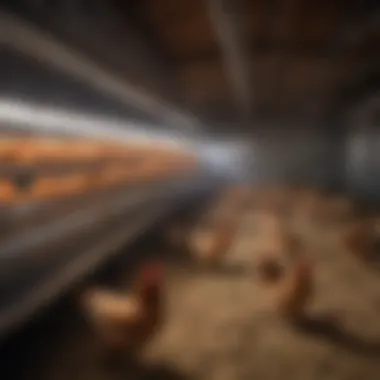
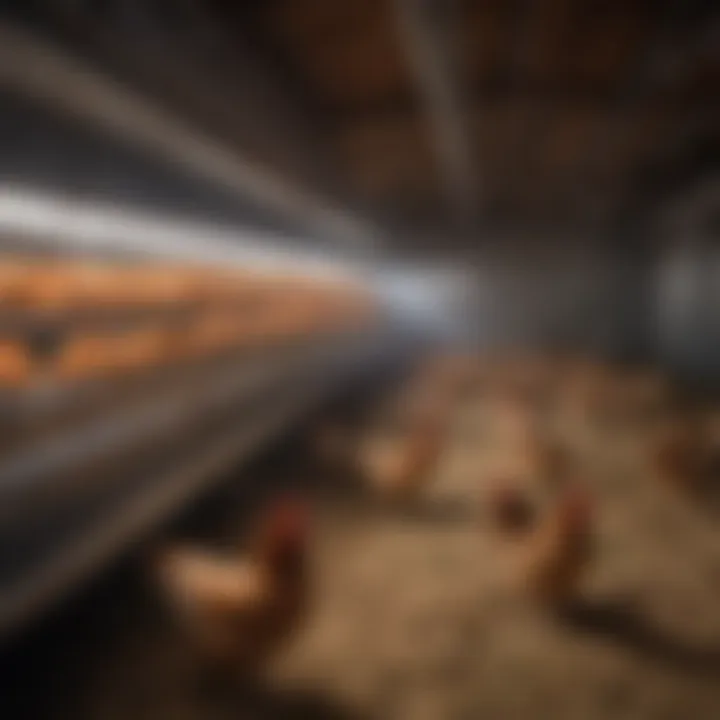
Proper installation and distribution of heat significantly impacts the overall health of the poultry, aiding in early growth and survival rates.
Correct installation and setup of electric brooder heaters lay the groundwork for successful poultry management. When executed thoughtfully, these practices not only ensure that chicks thrive, but they also enhance overall farm efficiency.
Health and Welfare of Chicks
The health and welfare of chicks hold paramount importance in poultry management. Young birds are particularly vulnerable as they are adapting to their new environment. Electric brooder heaters play a crucial role in ensuring that chicks receive adequate warmth, which directly affects their overall health. A properly managed brooding environment contributes to better growth rates, lower mortality, and enhanced productivity in the long run.
Thermal Comfort and Its Impact
Thermal comfort refers to the ideal temperature range that ensures chicks are not too hot or too cold. For newly hatched chicks, maintaining the right microclimate is essential. Chicks depend on external heat sources because they are unable to regulate their body temperature effectively during their early days. The optimal temperature generally ranges from 90°F to 95°F during the first week, gradually decreasing as they grow older.
When chicks are kept at their comfortable thermal range, several benefits can be observed:
- Improved feed conversion rates.
- Increased activity levels, which leads to better health.
- Enhanced immune response to disease.
- Decreased stress levels, allowing for more natural behavior.
In contrast, thermal discomfort can lead to severe consequences. Chicks that are too cold may huddle together to conserve warmth, leading to stress and vulnerability to disease. On the other hand, if they are too warm, chicks tend to spread out and can suffer from dehydration.
Signs of Overheating and Hypothermia
Recognizing the signs of overheating and hypothermia in chicks is vital for successful poultry management. Each condition has its specific symptoms that need careful monitoring.
Signs of Overheating:
- Excessive panting and open-mouth breathing.
- Reluctance to move or engage with other chicks.
- Lethargy or loss of appetite.
- Spread wings, an indication of heat stress.
Signs of Hypothermia:
- Chicks huddling together to maintain warmth.
- Cold extremities, especially feet and beak.
- Increased chirping or vocalization due to stress.
- Lack of activity and lethargy.
Adjustments in the heating setup should be made promptly if these signs are observed. Timeliness is essential to prevent further health complications and ensure the well-being of the flock.
Providing optimal thermal conditions using electric brooder heaters is fundamental for promoting chick health and overall productivity in poultry management.
Understanding and monitoring these aspects not only improve the individual welfare of chicks but also contribute significantly to the effectiveness of poultry farming.
Advantages of Electric Brooder Heaters
Electric brooder heaters offer numerous advantages that significantly enhance poultry management. These benefits must be considered by farmers as they directly impact the health and growth of chicks. Electric brooder heaters are designed to provide a stable environment, crucial for young birds in their early stages. Let’s delve into specific elements that highlight the importance of these heaters.
Consistent Temperature Maintenance
One of the primary advantages of electric brooder heaters is their ability to maintain a consistent temperature. Chicks are particularly sensitive to temperature fluctuations. If they become too cold or too hot, it can lead to stress and illness. Electric brooder heaters ensure that the temperature remains within a safe range. They are often equipped with thermostats that automatically regulate the heat output as needed.
- Stable Environment: Maintaining a steady temperature is essential for chicks' development. It promotes their metabolic processes, ensuring they thrive.
- Heat Distribution: Many electric brooders disperse heat uniformly across the space. This helps prevent areas that are too warm or too cool, offering a comfortable area for all chicks.
- Reduced Mortality Rates: A consistent environment reduces stress factors, which may lead to higher survival rates among chicks.
Ease of Use and Automation
Electric brooder heaters also stand out for their ease of use and automation features. Modern models simplify the management process for farmers, allowing them to focus on other essential aspects of poultry care. Users can set desired temperature levels, and the heater adjusts itself automatically, reducing the need for constant supervision.
- User-Friendly Controls: Most electric brooders come with simple controls. This allows even inexperienced farm workers to operate them without difficulty.
- Integrated Timers: Some models include timers that can automate heating cycles. This ensures that chicks have heat when it is critically needed without manual intervention.
- Remote Monitoring: Advanced models allow farmers to monitor temperature settings remotely. This helps in promptly addressing any issues that might arise, ensuring the chicks' welfare.
"Investing in electric brooder heaters is not just about comfort; it optimizes growth and improves overall farm efficiency."
Overall, employing electric brooder heaters in poultry management provides valuable advantages. They ensure consistent temperature maintenance and offer ease of use and automation. Farmers must understand these benefits to enhance chick health and improve production outcomes.
Challenges and Limitations
Electric brooder heaters, while essential in poultry management, do come with inherent challenges and limitations that farmers must consider. Understanding these aspects helps in making an informed decision when selecting heating solutions. This section emphasizes the importance of addressing these challenges for ensuring a balanced approach to poultry management.
Electrical Dependence
One significant challenge associated with electric brooder heaters is their dependence on a stable electrical supply. If the power goes out or there are fluctuations in voltage, it can greatly affect the heating process. Chicks are particularly sensitive to temperature changes, and any interruption in heating can lead to distress or even mortality.
Farmers must assess the reliability of their local electrical infrastructure before investing in electric brooder systems. Backup power solutions, such as generators or battery systems, could mitigate risks. Some farms may be in regions where power outages are common, making these considerations critical. In such cases, having a contingency plan for power interruptions is essential for ensuring the welfare of the poultry.
Initial Investment Costs
Another key limitation of electric brooder heaters is the initial investment cost. While these heaters typically operate at lower ongoing costs compared to some other heating methods, the upfront expenditure can be substantial. Quality electric brooders, especially models with advanced features like temperature controls and automation, can stretch the budget of even well-established farms.
Farmers should conduct a thorough cost-benefit analysis before making a purchase. Factors to consider includess:
- Purchase price of the heaters
- Installation expenses
- Possible operational costs over time
Investing in a higher-quality unit may prove beneficial in terms of durability and energy efficiency. Ultimately, understanding the long-term implications of these costs compared to immediate needs is crucial for sustainable poultry management.
Farmers should carefully evaluate both the electrical dependency and initial costs to optimize their poultry heating strategies.

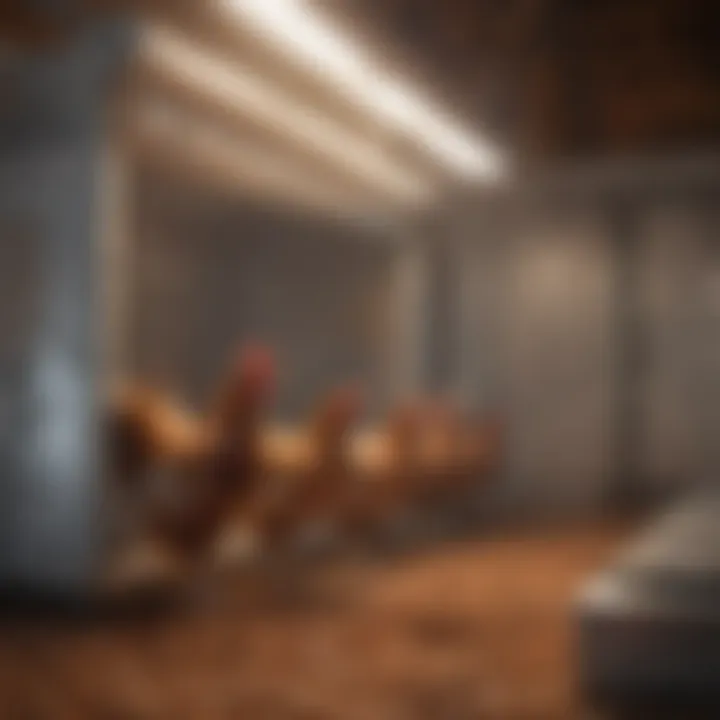
Innovation in Brooder Technology
Innovation in brooder technology plays a significant role in the modern poultry industry, particularly in improving the management practices of chick rearing. With the increasing demand for poultry products, there is a need for sophisticated heating solutions that ensure the health and welfare of chicks. Electric brooder heaters, with their technological advancements, offer various features that enhance efficiency in farming operations.
One of the primary benefits of innovation in this field is the improved energy efficiency of brooder heaters. Innovations such as smart heating systems allow for better temperature control and distribution, contributing to energy savings. This can lead to reduced operational costs in poultry farming. With the advances in technology, heaters are now being designed to adapt automatically to changing environmental conditions, ensuring chicks have a consistent thermal environment.
Moreover, the smart heating systems are particularly important. They enable monitoring and regulation of temperatures through mobile applications or integrated sensors. This added connectivity allows farmers to receive real-time data about the heating conditions and make adjustments as necessary from anywhere. The convenience of remote access prevents issues such as overheating or inadequate heating, which can have detrimental effects on chick survival and growth rates.
Smart Heating Systems
Smart heating systems represent a significant leap in the technology utilized for electric brooders. These systems are equipped with sensors that continuously monitor the ambient temperature and adjust the heater output accordingly. This responsiveness helps in maintaining an optimal environment for the chicks, which is vital for their health and growth.
The integration of IoT (Internet of Things) technology allows farmers to connect their brooders to the internet. This provides access to advanced monitoring systems that can track temperature fluctuations over time. Users can receive alerts if temperatures deviate beyond acceptable limits. Such proactive measures can help in preventing major losses.
In addition, smart systems often feature programmable settings, which allow users to set specific heating cycles based on the age and number of chicks. This adaptability not only promotes better management of resources but also enhances overall productivity.
Sustainable Energy Solutions
Sustainable energy solutions form another crucial aspect of innovation in brooder technology. The poultry industry faces growing pressure to reduce its environmental impact. Thus, many manufacturers are now developing electric brooder heaters that utilize renewable energy sources. These heaters may be designed to operate on solar power, significantly decreasing carbon footprints and offering lower operating costs.
Using sustainable energy options not only aligns with global trends toward greener practices but also fosters a more resilient poultry operation. Farmers can invest in solar panels to power their heating systems, providing advantages through energy independence and reduced reliance on traditional electricity sources. Moreover, this approach can lead to increased profitability as energy costs continue to rise.
Comparative Analysis with Alternative Heating Methods
In the realm of poultry management, selecting the right heating method is crucial for optimizing chick health and farm productivity. While electric brooder heaters are a popular choice, comparing them with alternative heating methods, such as gas heaters and wood-based heating, unveils important considerations. Understanding these alternatives helps farmers make informed decisions tailored to their specific operational needs.
Gas Heaters
Gas heaters are one of the widely used alternatives to electric brooder heaters. These systems typically use propane or natural gas to produce heat. One advantage of gas heaters is their ability to provide intense heat quickly. This makes them suitable for brooding chicks that require immediate warmth, particularly in cooler climates.
However, reliance on gas heaters comes with significant drawbacks. A primary concern is the potential for carbon monoxide emission, which can pose serious health risks to both poultry and farmers. Additionally, gas supply and regular maintenance can lead to higher operational costs over time. Farmers must also ensure proper ventilation when using these heaters, which can complicate the brooding environment.
In summary, while gas heaters can provide high-intensity warmth, the associated health risks and management requirements can limit their practicality for some poultry operations.
Wood-Based Heating
Wood-based heating systems have been employed in some poultry farms, especially in rural areas. This method harnesses the combustion of wood to generate heat. It’s often seen as a sustainable option, particularly when renewable wood resources are used. The initial setup costs can be lower compared to electric systems, making them accessible for smaller farms.
However, wood-based systems present challenges in terms of heat consistency and environmental control. The effectiveness of wood heat can fluctuate based on the type of wood used and its moisture content. Inconsistent heating can lead to stress in chicks, impacting their overall health.
Maintenance is another critical aspect. Regular cleaning of the flue and managing ash buildup is necessary to ensure efficient operation. The demand for constant monitoring can detract from the convenience of using modern electric brooder heaters.
Choosing the right heating method is fundamental. Each system offers unique benefits but also presents noteworthy challenges.
By evaluating the pros and cons of gas heaters and wood-based heating compared to electric brooder heaters, poultry farmers can make well-informed decisions that enhance efficiency and improve the well-being of their flocks.
Best Practices for Operating Electric Brooder Heaters
Operating electric brooder heaters effectively requires more than just basic knowledge. Best practices are essential for optimizing their performance and ensuring the well-being of poultry. Following these guidelines can lead to a more efficient brooding environment and better outcomes for chick health and growth.
Routine Maintenance Checks
Routine maintenance checks are critical to the longevity and safety of electric brooder heaters. First, it is essential to regularly inspect the electrical connections for any signs of wear, fraying wires, or loose fittings. Ensuring that connections are secure prevents overheating and reduces the risk of electrical fires.
Additionally, the heating components must be examined frequently. Dust and debris can accumulate on the heating elements, reducing their efficiency. A non-corrosive cleaner can safely eliminate this buildup without damaging the equipment. Every few weeks, check for any signs of rust or corrosion. If overlooked, these issues can lead to complete failure of the heater, which in turn compromises the chicks’ thermal environment.
Lastly, it is advisable to test the operational status of the heater. Regularly verifying that the thermostat is functional and accurately reading the temperature ensures that the heater can provide the necessary warmth when needed. This practice is important for early detection of defects that may affect performance, ultimately protecting the chicks from temperature extremes.
Monitoring Temperature Trends
Monitoring temperature trends is an integral part of effective brooding management. Operators should invest in reliable thermometers or automated temperature monitoring systems. These tools not only display real-time temperature but also track historical data which can reveal patterns.
Understanding the average temperature can help identify fluctuations that may affect chick health. Chicks need a stable environment to thrive; sudden spikes or drops can result in stress or health complications. Thus, consistent logging of temperature readings leads to better decision-making regarding adjustments to heater settings.
Moreover, incorporating data analysis can provide insights into how different setups perform under various conditions. For example:
- When to increase or decrease heater operational time based on outdoor temperature changes.
- Identifying the ideal placement of brooders for optimal heat distribution.
Such data not only guides operational adjustments but also improves long-term efficiency and productivity. By following these best practices, poultry managers can enhance their brooding process while safeguarding the health and welfare of the chicks.
Epilogue
In this article, we have established the pivotal role of electric brooder heaters in poultry management. These devices are essential in creating optimal thermal environments that are critical for the growth and development of chicks. Electric brooder heaters ensure consistent temperature control and adequate warmth, which directly influences chick health and, ultimately, farm productivity.
One significant benefit of employing electric brooder heaters is their ability to maintain a uniform temperature, which helps minimize stress among chicks. Fluctuations in heat can adversely affect their growth and immune systems, leading to health problems. By utilizing these heaters, poultry farmers can avoid such complications and promote healthy, productive flocks.
Moreover, the ease of use and the automation features of modern electric brooder heaters simplify the management processes on farms. Farmers can monitor temperature trends remotely, allowing for timely interventions if necessary.
Electric brooder heaters are not just tools; they are vital components in fostering the health and growth of poultry.
However, with these advantages come essential considerations. Initial investment costs and dependence on electricity represent notable factors that farmers must take into account. Innovations in brooder technology offer solutions, but awareness and careful planning are paramount.
In summary, electric brooder heaters are indispensable in poultry operations. They support improved chick welfare and farm efficiency, highlighting their critical role in modern poultry management. Farmers who prioritize proper heating solutions will likely see enhanced productivity and healthier birds.



